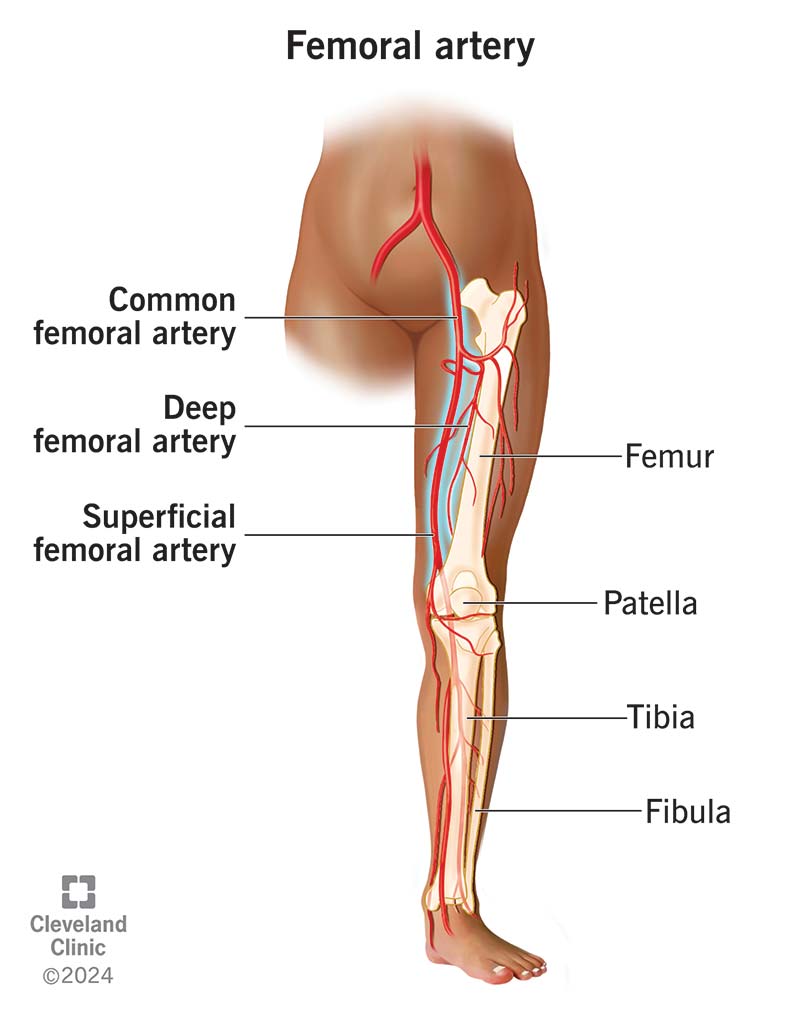The femoral artery is the main blood vessel supplying oxygen-rich blood to your lower body. It starts in your upper thigh, near your groin and runs down to the back of your knee. The function of the femoral artery and its branches is to supply your lower body with blood. Your tissues need blood to get oxygen and nutrients.
Advertisement
Cleveland Clinic is a non-profit academic medical center. Advertising on our site helps support our mission. We do not endorse non-Cleveland Clinic products or services. Policy

The femoral artery is a major blood vessel in your body. It carries blood from the bottom of your abdomen (belly) down through your lower limbs. This artery starts in the upper front part of your thigh, near the groin. It runs downward in a fairly straight line and separates into several branches along its route.
Advertisement
Cleveland Clinic is a non-profit academic medical center. Advertising on our site helps support our mission. We do not endorse non-Cleveland Clinic products or services. Policy
When you climb a flight of stairs or walk your dog, your femoral artery is hard at work. It’s making sure the leg muscles you’re using can get the oxygen and nutrients they need. You can thank your femoral artery for a continuous supply of blood that delivers the fuel for your leg muscles to move.
Your femoral artery and its branches supply your lower body with blood. Your body’s tissues need blood to get oxygen and nutrients. Like other arteries in your body, the femoral artery carries oxygen-rich blood away from your heart and to your body’s tissues.
The femoral vein runs alongside the femoral artery. This vein carries oxygen-poor blood from your lower body back up to your heart.
The location of the femoral artery is at the top of your thigh in an area called the femoral triangle. The triangle is just below your groin, which is the crease where your abdomen ends and your legs begin. The femoral artery runs to the lower thigh and ends behind the knee. At the knee, the femoral artery becomes the popliteal artery.
The anatomy of the femoral artery includes:
Advertisement
The common femoral artery is about 4 centimeters long (around an inch and a half). The deep and superficial portions continue down your leg. The diameter of the artery varies widely by sex, weight, height and ethnicity. But it’s usually between 7 and 8 millimeters across (about a quarter-inch).
The wide diameter of the common femoral artery makes it an ideal access point for endovascular procedures. A surgeon can insert a catheter (thin, flexible tube) into your femoral artery to access other blood vessels in your body, especially those near your heart.
The walls of all arteries, including your femoral artery, contain three layers:
Conditions that affect your femoral artery include:
Symptoms of femoral artery conditions may include:
In addition to a physical exam, a provider can use tests to check your femoral artery, like:
Treatments for your femoral artery may include:
You can keep your femoral artery and the rest of your blood vessels as healthy as possible by:
A complete, sudden blockage of your femoral artery is a medical emergency. Seek immediate medical attention if you experience:
Advertisement
Long-term narrowing or total blockage of the femoral artery can cause fatigue and painful cramping in your calf muscles when walking. In extreme situations, a blocked artery in your leg can lead to amputation (removal) of your toes, foot or leg. This may happen if the tissues don’t receive blood or oxygen for a prolonged period of time.
Because the femoral artery is large, an injury to it causes a lot of bleeding. You need emergency medical care for this. Healthcare providers can repair a femoral artery and save your leg if you get prompt care.
A lack of blood to your leg can cause leg tissue to die from lack of oxygen. This can lead to the need for leg amputation. Also, losing too much blood can be fatal.
When you have a blockage in your femoral artery, it causes pain in the muscles around it. This is because they aren’t getting the oxygen they need. With a gradual blockage, you may have mild pain that occurs first with exercise (like walking) and then progresses to pain at night with your legs elevated. But a sudden artery blockage causes more severe pain. The pain may feel like an ache or cramp. This may be associated with tingling, numbness, pallor and limited mobility of the affected leg.
Advertisement
You may not give much thought to your femoral artery in your day-to-day life. But if you have pain in your legs when you walk, your femoral artery is probably the reason. A blockage in this major blood vessel affects how much blood can get to your legs. You can reduce your risk of problems in your femoral artery by managing your blood pressure, staying physically active, eating nutritious foods, staying at a weight that’s healthy for you, managing diabetes and avoiding tobacco products.
Advertisement
When your heart needs some help, the cardiology experts at Cleveland Clinic are here for you. We diagnose and treat the full spectrum of cardiovascular diseases.

Last reviewed on 05/03/2024.
Learn more about the Health Library and our editorial process.